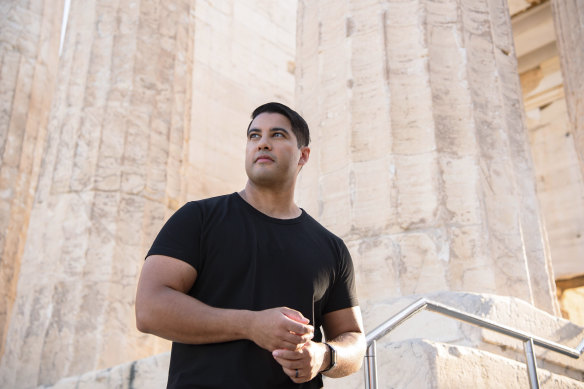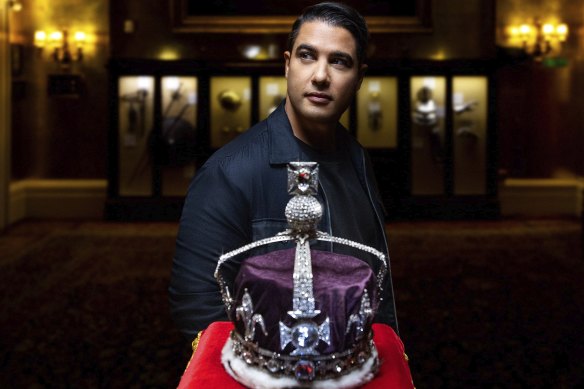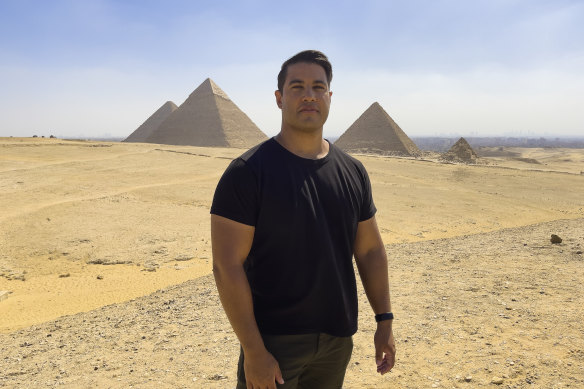Opinion
Queen Victoria had a dog called Looty. What does that tell you?
Peter FitzSimons
Columnist and authorMarc Fennell hosts the podcast and TV series Stuff the British Stole, the second season of which will screen on ABC TV (and stream on iView) from June 17. I spoke to him on Wednesday.
Fitz: Marc, what had you done in your media career up to the point of making this splendid series, to give you the weight to make it happen?
MF: I was the film critic for triple j for over a decade before doing ABC and SBS shows like Hungry Beast and The Feed – and from there I started doing documentaries and podcasts. I have had a career of chucking a lot of stuff at the wall and seeing what sticks, what people respond to.

Marc Fennell: An art historian “rattled off this long list of all of these objects that Britain had stolen, and I thought, ‘this has to be a thing’.”Credit:
Fitz: And where did the concept of Stuff the British Stole come from?
MF: It started as a fun riff that developed between me and my former co-host Jan Fran, when we were doing a podcast at SBS. And when I was in London at the end of 2019, I went round and pitched it to British broadcasters and platforms – originally just talking about all this stuff in the British Museum that they had taken from other nations they’d invaded and colonised – because my thought was that the series should be made by them. That shows how naive I was. They all kind of just either looked at me blankly or were amused: This is funny, can we really have stolen that much stuff? How can that possibly be? The meetings were so awkward, I remember thinking, “I will just pay for my coffee and leave.”
Fitz: And the breakthrough?
MF: Well, on the last day before leaving Britain, I thought I’ll just interview one person who I know is an expert in it, art historian Alice Proctor, and she just rattled off this extraordinarily long list of all of these objects that Britain had stolen and as soon as she was done, I thought, “this has to be a thing”. I came back, pitched to the ABC, and they agreed.
Fitz: And it took off!
MF: It did. And its subsequent success has amazed me because, in my mind, I was making this really unusual niche show, but as soon as we broadcast the first episode of the podcast, it shot to No.1, not just in Australia but in a few other places around the world. I think it captured something, rode the wave of new attitudes to the past. But to this day, no one’s more shocked by its success than me.

Fennell with some of Britain’s crown jewels. “I’d actually love to talk to the ... royal family.”
Fitz: I want to get to the upcoming series, but do you share my outrage about the Gweagal Shield – dropped by the Indigenous warrior after being shot by Captain Cook on the first landing and now bloody well on display to the public in the modest “Cabinet 198″ at the British Museum, when it is bloody well OURS, not THEIRS? It is one of the three most holy relics of Australia, with the Eureka flag and Ned Kelly’s armour. And it shouldn’t be in BRITAIN!
MF: [A little taken aback.] Yes, it is ours. We have done a podcast episode on the Gweagal Shield. I think there are some complexities to where exactly it comes from. And I think in all that complexity, it doesn’t change the fact that it is a powerful symbol of the first interactions between British people and Australia’s First Nations people. And the fact that it is a shield – a symbol of defence on a land that the British took by force – well, the symbolism of that is not lost on me. What I find interesting about that, and so many other objects we cover, is the difference between what it means here versus what it means there. They are two very different things.
Fitz: Go on ...
MF: The British often regarded these objects as things they took to help categorise the rest of the world, to put it in a hierarchy of knowledge – so you can come to one place, a museum, and you can learn about places that are far away. But, here, and for many colonised and sometimes still traumatised communities around the world, it means treasures they stole. And in many places, the hurt is still there.
Fitz: At the time, did the people who actually took the treasures know they were stealing them, or did they do it in the spirit of Sir Joseph Banks, gathering so many botanical and animal specimens on Cook’s trip to Australia that they still haven’t all been opened?
MF: That’s a great question, and it really varies from object to object. But I often think of the horrific sacking of the Summer Palace in China in 1860 by British and French forces, which saw the shocking destruction of a truly incredible palace and gardens. And one of the things they took was a fluffy dog said to belong to the emperor’s aunt, which was given to Queen Victoria. And the English queen literally named the dog “Looty” – as in the result of looting. So, I think to suggest that they weren’t aware they were stealing is disingenuous.

Fennell in Egypt. “At the end of the day, the British Empire dominated the world through force.”
Fitz: So, what can we look forward to in the coming season?
MF: It’s the biggest season we’ve done either in podcast or television: eight episodes, shot in 11 different countries. It will include the Parthenon sculptures, previously known as the Elgin Marbles, and Stephen Fry joins me on that episode. We have the story of a perfect sphinx statue in the British Museum that is actually from a remote Canadian island, of all places. I am haunted by the story of a tiny black doll, given to an Indigenous girl who was taken by a white family in Tasmania. The doll was likely her only connection to people who looked like her. When the family went back to the UK, they abandoned the girl at the orphanage and took her beloved doll with them.
Fitz: I weep.
MF: Then there’s incredible story of how an Egyptian mummified child ended up all the way in the distant British colony of New South Wales, now stored at Sydney University. And we look at the enormous Cullinan Diamond – the “Star of Africa”– that millions watched King Charles wear in his coronation.
Fitz: You are covering a lot of ground.
MF: Yes, and a lot of history. I think the reason why I love making this particular series so much is because each object is a doorway to a story, not just of the thing itself, but a whole chapter of history. Often, when we tell the story of the British Empire in colonial countries, it’s quite rose-tinted, viewed as being somewhat like a passive good: “Well, we ended up with laws and railways.” And I don’t disagree with that. But there’s a whole other part of that history that often isn’t told, and I think we can do both and tell the story of what it was like to have precious things stolen from you and still kept thousands of kilometres away.
Fitz: What’s the best, pure story?
MF: My favourite one is the story of an Irish giant who was body snatched after his death in the most outrageous circumstances. He was allegedly nearly eight feet – 2.3 metres – and the reason I find this story so fascinating is he was very clear that he didn’t want his body dissected by scientists after he died. But they did exactly that, but then remarkable scientific discoveries were made from that theft that have actually saved people’s lives. So it’s a really conflicted story. But history is often messy.
Fitz: Most scarifying yarn?
MF: It’s from an episode we shot in Kenya. When the British Empire was winding down and countries like Kenya were becoming independent, the UK Foreign Office sent a directive to the local colonial administrations, saying, “Take evidence that might embarrass Her Majesty’s government and either burn it or send it back to England.” They later called it “Operation Legacy”. The UK government then denied they had such documents for decades until a court case forced them to reveal them.
Fitz: And what did these national documents that the British stole reveal?
MF: They contain evidence of torture that the UK government in London absolutely knew about. It is just extraordinary. People occasionally critique the show – “Well, it all happened in the past” – but this happened in the 20th century, and there are people who suffered that torture who are still alive now! It’s probably the episode that has the most symbolism for me because when you take evidence like that, what you’re actually stealing is documented history itself. And so every episode this season is really different and it took most of last year for me to make it, travelling all around the world. But they are stories that actually tell us how we ended up with the world we have today.
Fitz: In some ways, you are venturing towards the frontlines of the culture wars.
MF: Perhaps. People sometimes say to me that the British weren’t the only people to steal things. I mean, the Mongolians stole things, the Spanish, Portuguese and Romans stole things – that’s of course absolutely true. But we don’t start parliament with “hail Caesar!” and we don’t have the face of Genghis Khan on our coins. That’s why it’s important to interrogate the legacy of the British first.
Fitz: Fair point. Let’s start by getting “King Charles” off our coins!
MF: I’d actually love to talk to the British royal family. I feel like there’s a good conversation to be had with the royals about this territory. Because I think at this point in their history, they probably are ready to reckon with stuff the British stole.
Fitz: Because it was under the authority of their predecessor kings and queens that so many of their former colonies were pillaged of treasures, and it is time they addressed it, apologised for it, and gave everything back?
MF: Yes. I mean, if you take the Queen, her greatest legacy is that she presided over the transition from empire to Commonwealth – a transition from dominating force to, nominally, “a big, warm, happy family”. The problem for me is that whilst that’s nice, it obscures the reality of how the British Empire came to dominate the world.
Fitz: Tell us ...
MF: At the end of the day, the British Empire dominated the world through force. Sometimes it was military force, and sometimes it was economic force. Once people watch or listen to the show, they quickly realise that it’s not as Brit-bashing as it may seem. That’s because it’s too simplistic to frame the British Empire as simply the bad guys of history. But it’s equally simplistic to pretend it was just this benevolent force binding a bunch of countries together so we could take part in the Commonwealth Games. It’s more complicated and messier than that, and I think it’s OK for us to acknowledge the “bad” history as well as the “good” that been told for so long.
Fitz: If you do talk to Prince William, there’s one thing you must ask him.
MF: Where is Pemulwuy’s head?
Fitz: Exactly, where is the great warrior Pemulwuy’s head! It was severed by Henry Hacking 225 years ago and sent to the British Museum. A decade ago, William promised to intervene to get them to make greater efforts to find it, to repatriate it, but still nothing.
MF: I would like to ask him that. I’d be surprised if they are hiding it. They just have so much stuff, it may genuinely be they can’t actually find it.
Fitz: Now, you’ve just got a big award in Canada this week for the best history documentary program or series from the Canadian Screen Guild, and your success continues to grow. I presume you’d “like to thank the Academy and Jesus, without whom none of this would be possible”?
MF: [Laughing.] No, I’d like to thank the team, in fact, our teams working across Australia and Canada, as we have co-produced the TV series with the Canadian Broadcasting Corporation. I think the most important thanks is to the podcast producer from the beginning, Zoe Ferguson. But to be honest with you, there’s one group of people I owe most of all: that’s my wife and kids who I have to leave behind for months on end to do the show, to play Indiana Jones in reverse. It’s an amazing job, and I often think how strange it is that it all started from me with a tiny microphone and an idea in a dingy hall in London – to now, where it sends me all around the world. It’s an amazing trajectory, and I never know where it is going to take me next, but it feels like it’s important work.
Fitz: It is. Bravo.
Get a weekly wrap of views that will challenge, champion and inform your own. Sign up for our Opinion newsletter.